MGT8075 Project Delivery: Critical Analysis of SMK Mengkuang Project
VerifiedAdded on 2023/06/07
|20
|5404
|153
Report
AI Summary
This report provides an in-depth analysis of the project delivery approach for the proposed one-block four-storey building for SMK Mengkuang, Malaysia. It examines the project's requirements definition, tendering methodologies, contract formation and management, and closeout processes. The report critically analyzes the tools and processes used by the project team, including expert judgment, data gathering, decision-making, and data representation. It also explores different tendering methods, such as open, selective, and negotiated tendering, and the procurement tools used to acquire goods and services. The analysis reflects on aspects of contract formation and management, including the achievement of contract objectives and knowledge transfer. The report concludes with findings, recommendations, and lessons learned for future projects, emphasizing the importance of strict rules and regulations for construction management to ensure timely completion of projects.
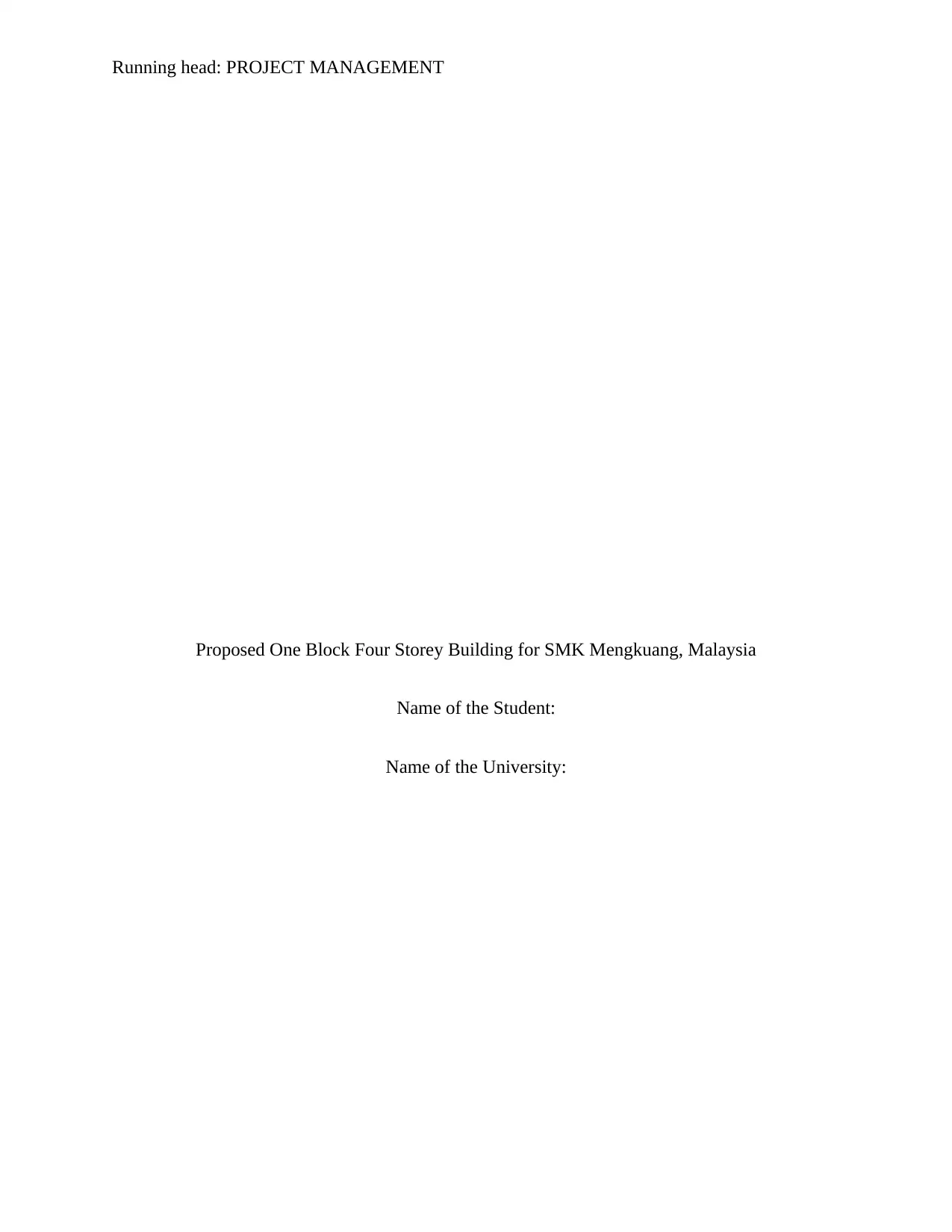
Running head: PROJECT MANAGEMENT
Proposed One Block Four Storey Building for SMK Mengkuang, Malaysia
Name of the Student:
Name of the University:
Proposed One Block Four Storey Building for SMK Mengkuang, Malaysia
Name of the Student:
Name of the University:
Paraphrase This Document
Need a fresh take? Get an instant paraphrase of this document with our AI Paraphraser
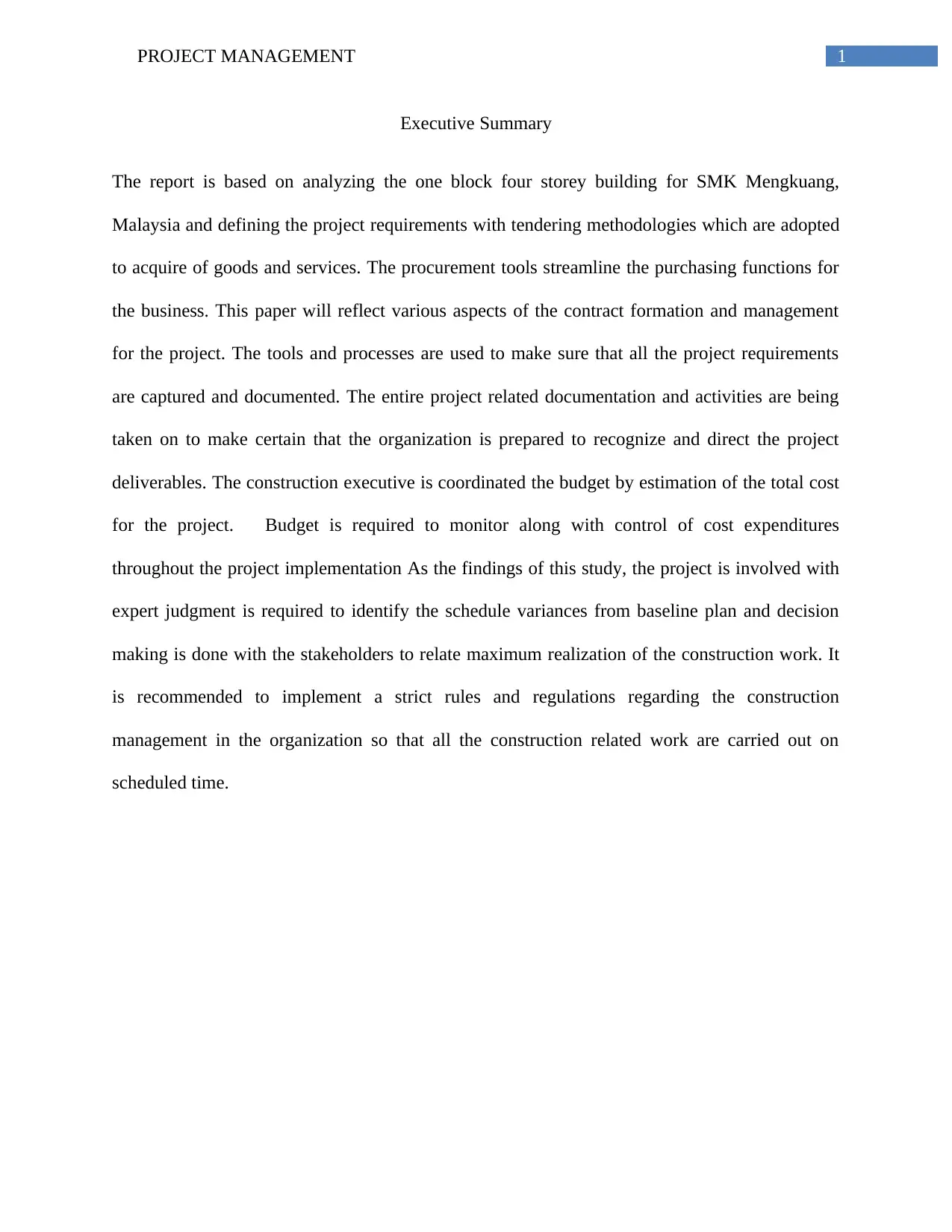
1PROJECT MANAGEMENT
Executive Summary
The report is based on analyzing the one block four storey building for SMK Mengkuang,
Malaysia and defining the project requirements with tendering methodologies which are adopted
to acquire of goods and services. The procurement tools streamline the purchasing functions for
the business. This paper will reflect various aspects of the contract formation and management
for the project. The tools and processes are used to make sure that all the project requirements
are captured and documented. The entire project related documentation and activities are being
taken on to make certain that the organization is prepared to recognize and direct the project
deliverables. The construction executive is coordinated the budget by estimation of the total cost
for the project. Budget is required to monitor along with control of cost expenditures
throughout the project implementation As the findings of this study, the project is involved with
expert judgment is required to identify the schedule variances from baseline plan and decision
making is done with the stakeholders to relate maximum realization of the construction work. It
is recommended to implement a strict rules and regulations regarding the construction
management in the organization so that all the construction related work are carried out on
scheduled time.
Executive Summary
The report is based on analyzing the one block four storey building for SMK Mengkuang,
Malaysia and defining the project requirements with tendering methodologies which are adopted
to acquire of goods and services. The procurement tools streamline the purchasing functions for
the business. This paper will reflect various aspects of the contract formation and management
for the project. The tools and processes are used to make sure that all the project requirements
are captured and documented. The entire project related documentation and activities are being
taken on to make certain that the organization is prepared to recognize and direct the project
deliverables. The construction executive is coordinated the budget by estimation of the total cost
for the project. Budget is required to monitor along with control of cost expenditures
throughout the project implementation As the findings of this study, the project is involved with
expert judgment is required to identify the schedule variances from baseline plan and decision
making is done with the stakeholders to relate maximum realization of the construction work. It
is recommended to implement a strict rules and regulations regarding the construction
management in the organization so that all the construction related work are carried out on
scheduled time.
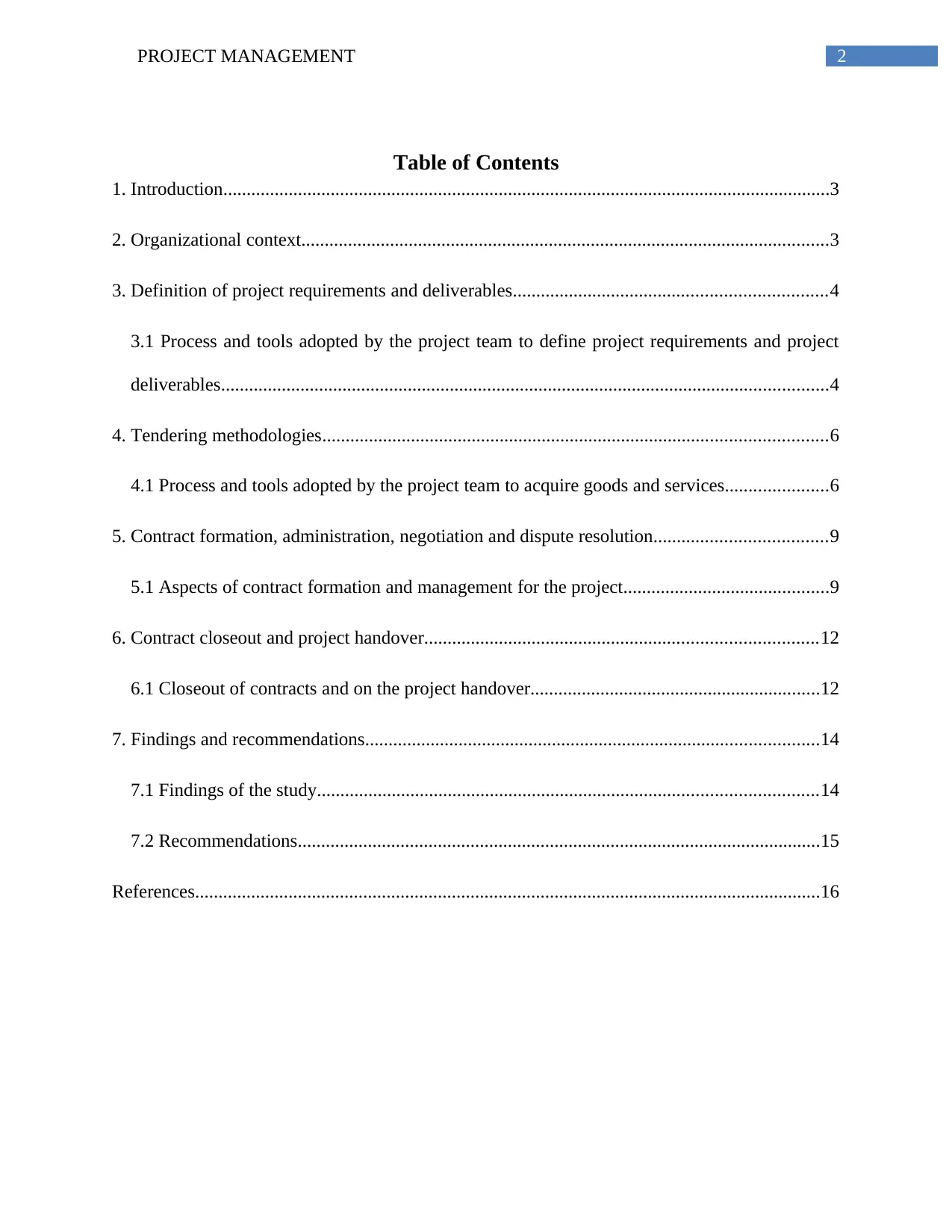
2PROJECT MANAGEMENT
Table of Contents
1. Introduction..................................................................................................................................3
2. Organizational context.................................................................................................................3
3. Definition of project requirements and deliverables...................................................................4
3.1 Process and tools adopted by the project team to define project requirements and project
deliverables..................................................................................................................................4
4. Tendering methodologies............................................................................................................6
4.1 Process and tools adopted by the project team to acquire goods and services......................6
5. Contract formation, administration, negotiation and dispute resolution.....................................9
5.1 Aspects of contract formation and management for the project............................................9
6. Contract closeout and project handover....................................................................................12
6.1 Closeout of contracts and on the project handover..............................................................12
7. Findings and recommendations.................................................................................................14
7.1 Findings of the study...........................................................................................................14
7.2 Recommendations................................................................................................................15
References......................................................................................................................................16
Table of Contents
1. Introduction..................................................................................................................................3
2. Organizational context.................................................................................................................3
3. Definition of project requirements and deliverables...................................................................4
3.1 Process and tools adopted by the project team to define project requirements and project
deliverables..................................................................................................................................4
4. Tendering methodologies............................................................................................................6
4.1 Process and tools adopted by the project team to acquire goods and services......................6
5. Contract formation, administration, negotiation and dispute resolution.....................................9
5.1 Aspects of contract formation and management for the project............................................9
6. Contract closeout and project handover....................................................................................12
6.1 Closeout of contracts and on the project handover..............................................................12
7. Findings and recommendations.................................................................................................14
7.1 Findings of the study...........................................................................................................14
7.2 Recommendations................................................................................................................15
References......................................................................................................................................16
⊘ This is a preview!⊘
Do you want full access?
Subscribe today to unlock all pages.

Trusted by 1+ million students worldwide
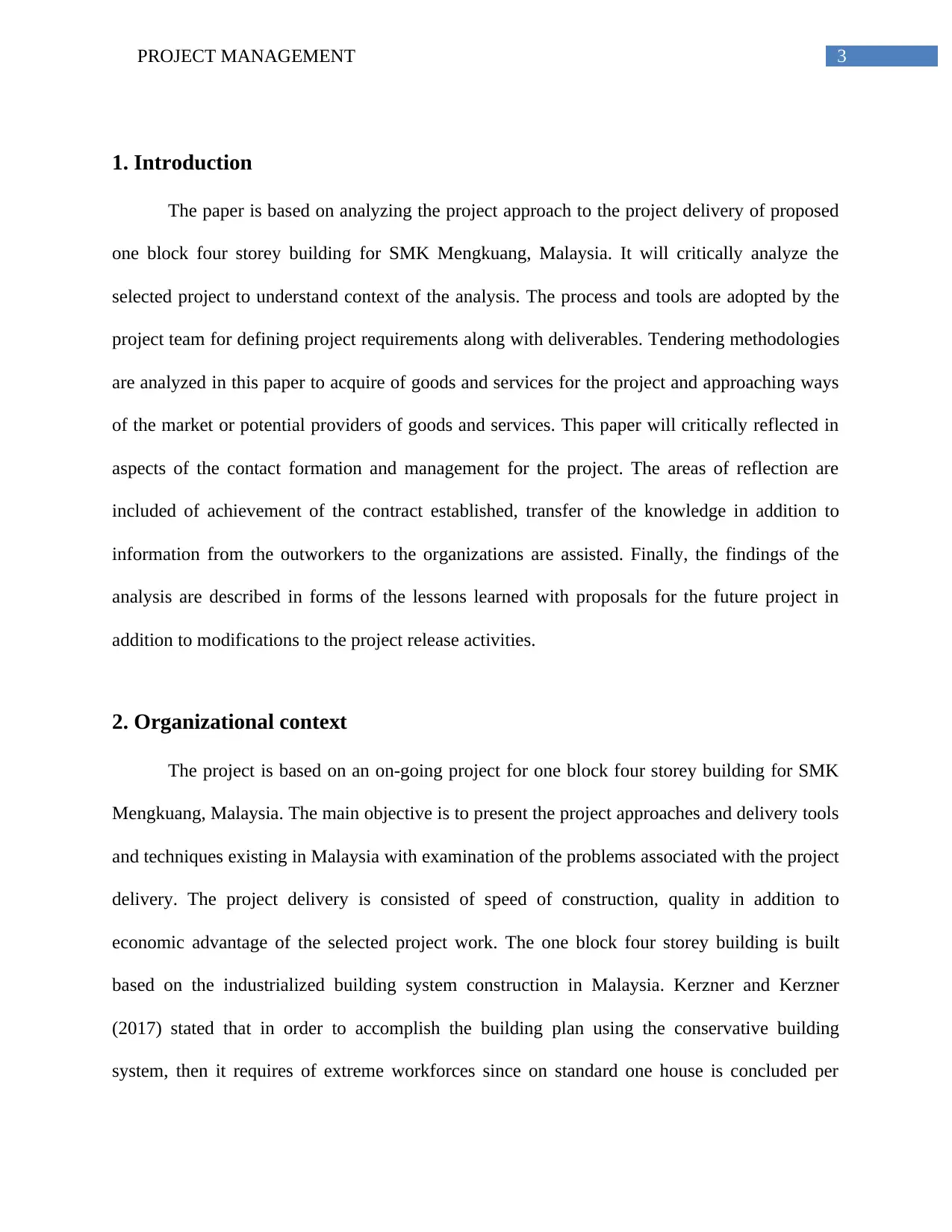
3PROJECT MANAGEMENT
1. Introduction
The paper is based on analyzing the project approach to the project delivery of proposed
one block four storey building for SMK Mengkuang, Malaysia. It will critically analyze the
selected project to understand context of the analysis. The process and tools are adopted by the
project team for defining project requirements along with deliverables. Tendering methodologies
are analyzed in this paper to acquire of goods and services for the project and approaching ways
of the market or potential providers of goods and services. This paper will critically reflected in
aspects of the contact formation and management for the project. The areas of reflection are
included of achievement of the contract established, transfer of the knowledge in addition to
information from the outworkers to the organizations are assisted. Finally, the findings of the
analysis are described in forms of the lessons learned with proposals for the future project in
addition to modifications to the project release activities.
2. Organizational context
The project is based on an on-going project for one block four storey building for SMK
Mengkuang, Malaysia. The main objective is to present the project approaches and delivery tools
and techniques existing in Malaysia with examination of the problems associated with the project
delivery. The project delivery is consisted of speed of construction, quality in addition to
economic advantage of the selected project work. The one block four storey building is built
based on the industrialized building system construction in Malaysia. Kerzner and Kerzner
(2017) stated that in order to accomplish the building plan using the conservative building
system, then it requires of extreme workforces since on standard one house is concluded per
1. Introduction
The paper is based on analyzing the project approach to the project delivery of proposed
one block four storey building for SMK Mengkuang, Malaysia. It will critically analyze the
selected project to understand context of the analysis. The process and tools are adopted by the
project team for defining project requirements along with deliverables. Tendering methodologies
are analyzed in this paper to acquire of goods and services for the project and approaching ways
of the market or potential providers of goods and services. This paper will critically reflected in
aspects of the contact formation and management for the project. The areas of reflection are
included of achievement of the contract established, transfer of the knowledge in addition to
information from the outworkers to the organizations are assisted. Finally, the findings of the
analysis are described in forms of the lessons learned with proposals for the future project in
addition to modifications to the project release activities.
2. Organizational context
The project is based on an on-going project for one block four storey building for SMK
Mengkuang, Malaysia. The main objective is to present the project approaches and delivery tools
and techniques existing in Malaysia with examination of the problems associated with the project
delivery. The project delivery is consisted of speed of construction, quality in addition to
economic advantage of the selected project work. The one block four storey building is built
based on the industrialized building system construction in Malaysia. Kerzner and Kerzner
(2017) stated that in order to accomplish the building plan using the conservative building
system, then it requires of extreme workforces since on standard one house is concluded per
Paraphrase This Document
Need a fresh take? Get an instant paraphrase of this document with our AI Paraphraser
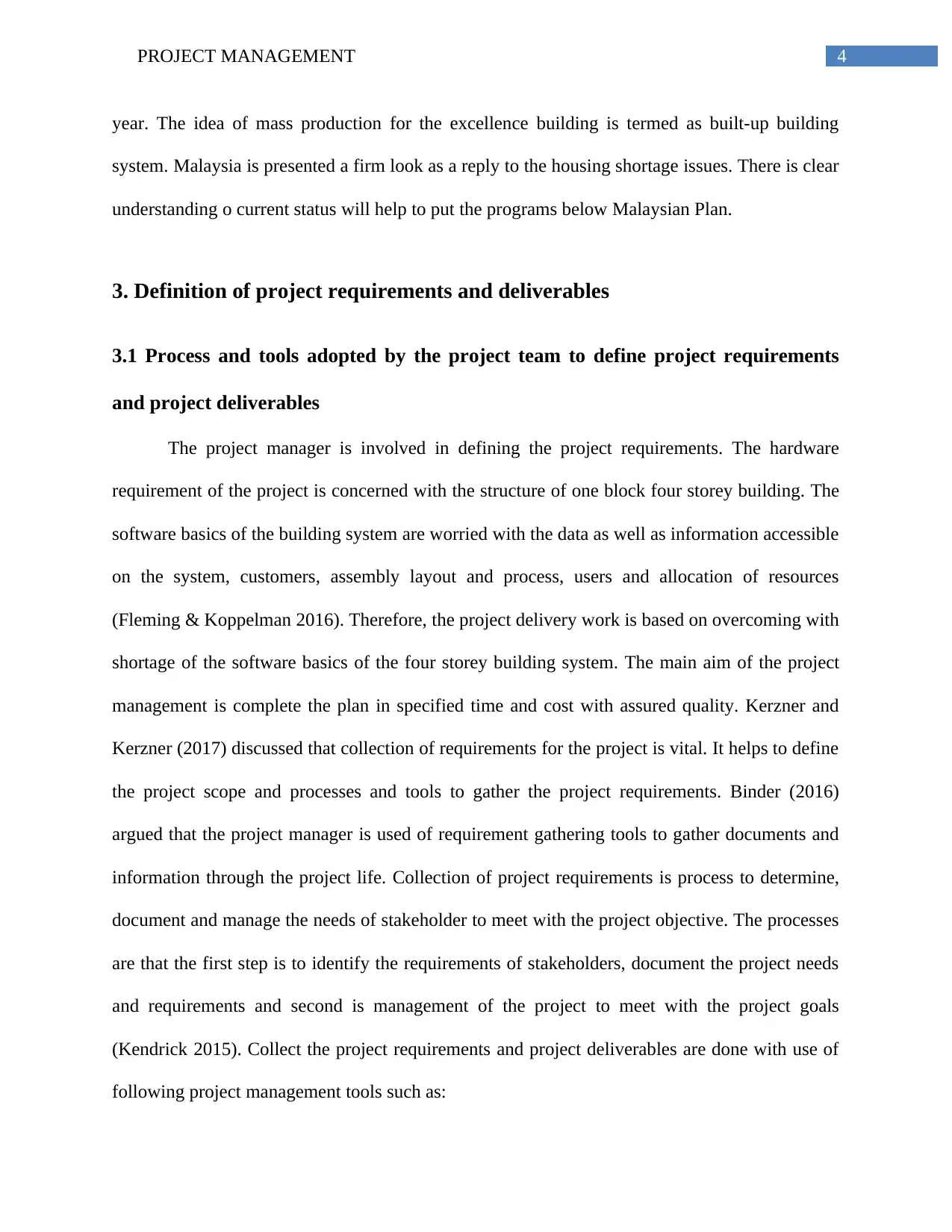
4PROJECT MANAGEMENT
year. The idea of mass production for the excellence building is termed as built-up building
system. Malaysia is presented a firm look as a reply to the housing shortage issues. There is clear
understanding o current status will help to put the programs below Malaysian Plan.
3. Definition of project requirements and deliverables
3.1 Process and tools adopted by the project team to define project requirements
and project deliverables
The project manager is involved in defining the project requirements. The hardware
requirement of the project is concerned with the structure of one block four storey building. The
software basics of the building system are worried with the data as well as information accessible
on the system, customers, assembly layout and process, users and allocation of resources
(Fleming & Koppelman 2016). Therefore, the project delivery work is based on overcoming with
shortage of the software basics of the four storey building system. The main aim of the project
management is complete the plan in specified time and cost with assured quality. Kerzner and
Kerzner (2017) discussed that collection of requirements for the project is vital. It helps to define
the project scope and processes and tools to gather the project requirements. Binder (2016)
argued that the project manager is used of requirement gathering tools to gather documents and
information through the project life. Collection of project requirements is process to determine,
document and manage the needs of stakeholder to meet with the project objective. The processes
are that the first step is to identify the requirements of stakeholders, document the project needs
and requirements and second is management of the project to meet with the project goals
(Kendrick 2015). Collect the project requirements and project deliverables are done with use of
following project management tools such as:
year. The idea of mass production for the excellence building is termed as built-up building
system. Malaysia is presented a firm look as a reply to the housing shortage issues. There is clear
understanding o current status will help to put the programs below Malaysian Plan.
3. Definition of project requirements and deliverables
3.1 Process and tools adopted by the project team to define project requirements
and project deliverables
The project manager is involved in defining the project requirements. The hardware
requirement of the project is concerned with the structure of one block four storey building. The
software basics of the building system are worried with the data as well as information accessible
on the system, customers, assembly layout and process, users and allocation of resources
(Fleming & Koppelman 2016). Therefore, the project delivery work is based on overcoming with
shortage of the software basics of the four storey building system. The main aim of the project
management is complete the plan in specified time and cost with assured quality. Kerzner and
Kerzner (2017) discussed that collection of requirements for the project is vital. It helps to define
the project scope and processes and tools to gather the project requirements. Binder (2016)
argued that the project manager is used of requirement gathering tools to gather documents and
information through the project life. Collection of project requirements is process to determine,
document and manage the needs of stakeholder to meet with the project objective. The processes
are that the first step is to identify the requirements of stakeholders, document the project needs
and requirements and second is management of the project to meet with the project goals
(Kendrick 2015). Collect the project requirements and project deliverables are done with use of
following project management tools such as:
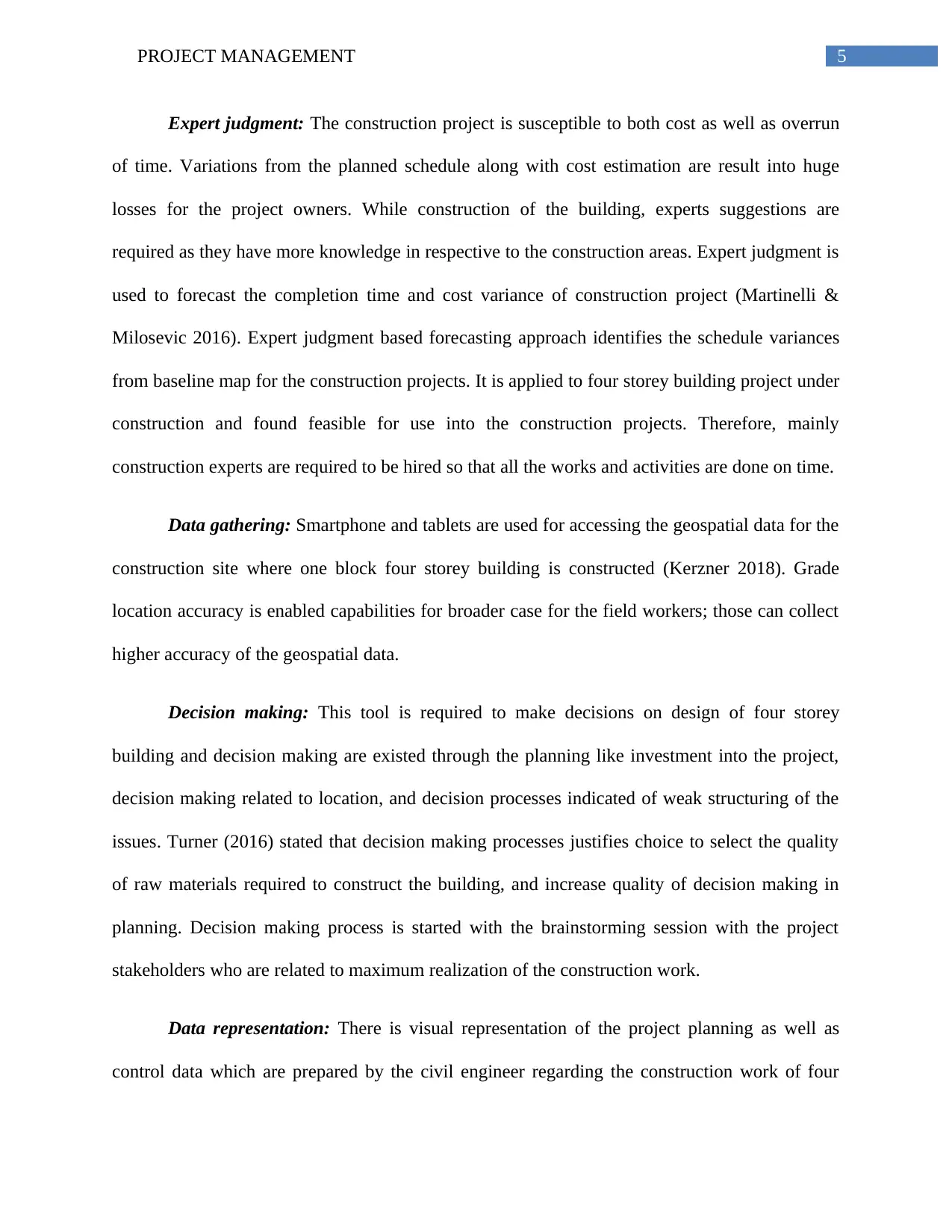
5PROJECT MANAGEMENT
Expert judgment: The construction project is susceptible to both cost as well as overrun
of time. Variations from the planned schedule along with cost estimation are result into huge
losses for the project owners. While construction of the building, experts suggestions are
required as they have more knowledge in respective to the construction areas. Expert judgment is
used to forecast the completion time and cost variance of construction project (Martinelli &
Milosevic 2016). Expert judgment based forecasting approach identifies the schedule variances
from baseline map for the construction projects. It is applied to four storey building project under
construction and found feasible for use into the construction projects. Therefore, mainly
construction experts are required to be hired so that all the works and activities are done on time.
Data gathering: Smartphone and tablets are used for accessing the geospatial data for the
construction site where one block four storey building is constructed (Kerzner 2018). Grade
location accuracy is enabled capabilities for broader case for the field workers; those can collect
higher accuracy of the geospatial data.
Decision making: This tool is required to make decisions on design of four storey
building and decision making are existed through the planning like investment into the project,
decision making related to location, and decision processes indicated of weak structuring of the
issues. Turner (2016) stated that decision making processes justifies choice to select the quality
of raw materials required to construct the building, and increase quality of decision making in
planning. Decision making process is started with the brainstorming session with the project
stakeholders who are related to maximum realization of the construction work.
Data representation: There is visual representation of the project planning as well as
control data which are prepared by the civil engineer regarding the construction work of four
Expert judgment: The construction project is susceptible to both cost as well as overrun
of time. Variations from the planned schedule along with cost estimation are result into huge
losses for the project owners. While construction of the building, experts suggestions are
required as they have more knowledge in respective to the construction areas. Expert judgment is
used to forecast the completion time and cost variance of construction project (Martinelli &
Milosevic 2016). Expert judgment based forecasting approach identifies the schedule variances
from baseline map for the construction projects. It is applied to four storey building project under
construction and found feasible for use into the construction projects. Therefore, mainly
construction experts are required to be hired so that all the works and activities are done on time.
Data gathering: Smartphone and tablets are used for accessing the geospatial data for the
construction site where one block four storey building is constructed (Kerzner 2018). Grade
location accuracy is enabled capabilities for broader case for the field workers; those can collect
higher accuracy of the geospatial data.
Decision making: This tool is required to make decisions on design of four storey
building and decision making are existed through the planning like investment into the project,
decision making related to location, and decision processes indicated of weak structuring of the
issues. Turner (2016) stated that decision making processes justifies choice to select the quality
of raw materials required to construct the building, and increase quality of decision making in
planning. Decision making process is started with the brainstorming session with the project
stakeholders who are related to maximum realization of the construction work.
Data representation: There is visual representation of the project planning as well as
control data which are prepared by the civil engineer regarding the construction work of four
⊘ This is a preview!⊘
Do you want full access?
Subscribe today to unlock all pages.

Trusted by 1+ million students worldwide
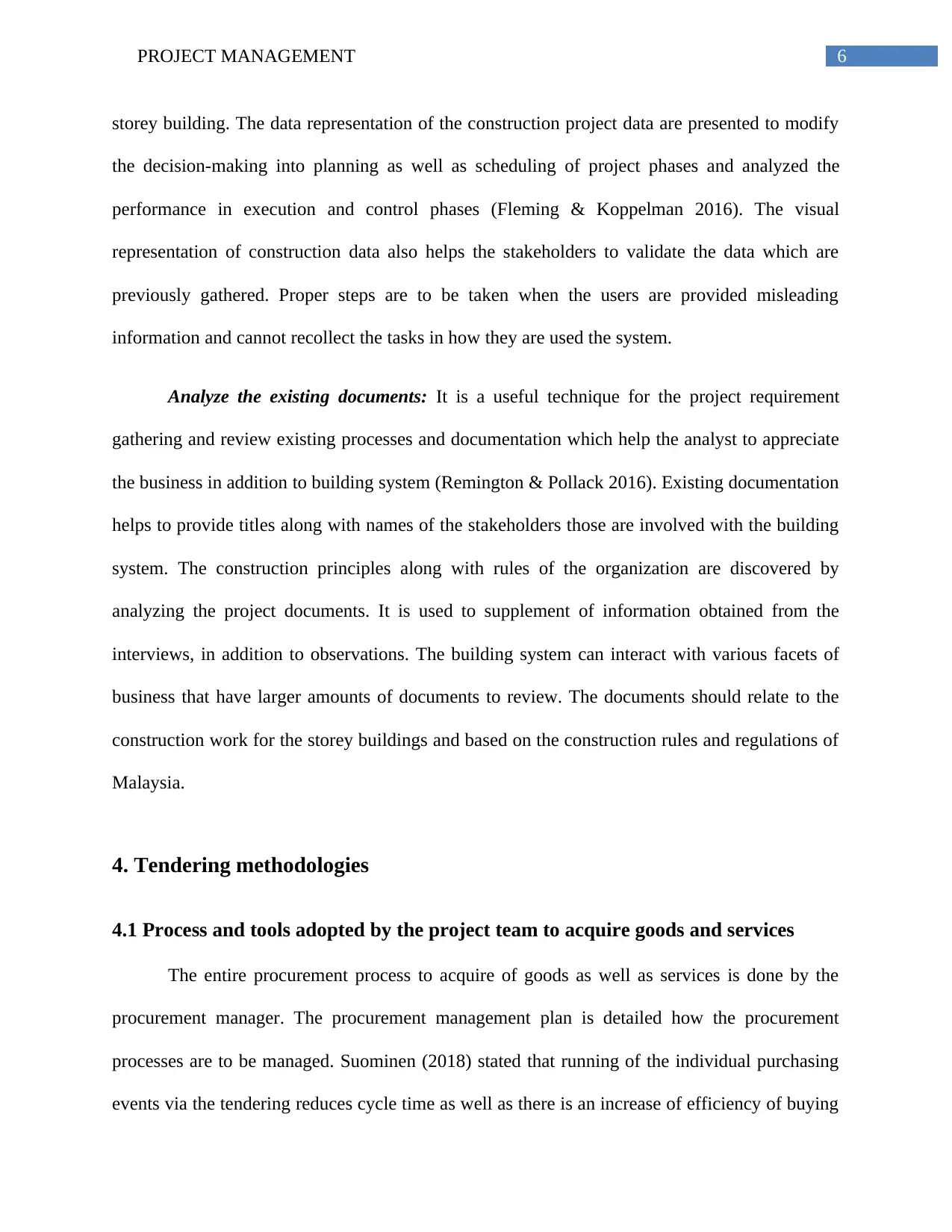
6PROJECT MANAGEMENT
storey building. The data representation of the construction project data are presented to modify
the decision-making into planning as well as scheduling of project phases and analyzed the
performance in execution and control phases (Fleming & Koppelman 2016). The visual
representation of construction data also helps the stakeholders to validate the data which are
previously gathered. Proper steps are to be taken when the users are provided misleading
information and cannot recollect the tasks in how they are used the system.
Analyze the existing documents: It is a useful technique for the project requirement
gathering and review existing processes and documentation which help the analyst to appreciate
the business in addition to building system (Remington & Pollack 2016). Existing documentation
helps to provide titles along with names of the stakeholders those are involved with the building
system. The construction principles along with rules of the organization are discovered by
analyzing the project documents. It is used to supplement of information obtained from the
interviews, in addition to observations. The building system can interact with various facets of
business that have larger amounts of documents to review. The documents should relate to the
construction work for the storey buildings and based on the construction rules and regulations of
Malaysia.
4. Tendering methodologies
4.1 Process and tools adopted by the project team to acquire goods and services
The entire procurement process to acquire of goods as well as services is done by the
procurement manager. The procurement management plan is detailed how the procurement
processes are to be managed. Suominen (2018) stated that running of the individual purchasing
events via the tendering reduces cycle time as well as there is an increase of efficiency of buying
storey building. The data representation of the construction project data are presented to modify
the decision-making into planning as well as scheduling of project phases and analyzed the
performance in execution and control phases (Fleming & Koppelman 2016). The visual
representation of construction data also helps the stakeholders to validate the data which are
previously gathered. Proper steps are to be taken when the users are provided misleading
information and cannot recollect the tasks in how they are used the system.
Analyze the existing documents: It is a useful technique for the project requirement
gathering and review existing processes and documentation which help the analyst to appreciate
the business in addition to building system (Remington & Pollack 2016). Existing documentation
helps to provide titles along with names of the stakeholders those are involved with the building
system. The construction principles along with rules of the organization are discovered by
analyzing the project documents. It is used to supplement of information obtained from the
interviews, in addition to observations. The building system can interact with various facets of
business that have larger amounts of documents to review. The documents should relate to the
construction work for the storey buildings and based on the construction rules and regulations of
Malaysia.
4. Tendering methodologies
4.1 Process and tools adopted by the project team to acquire goods and services
The entire procurement process to acquire of goods as well as services is done by the
procurement manager. The procurement management plan is detailed how the procurement
processes are to be managed. Suominen (2018) stated that running of the individual purchasing
events via the tendering reduces cycle time as well as there is an increase of efficiency of buying
Paraphrase This Document
Need a fresh take? Get an instant paraphrase of this document with our AI Paraphraser
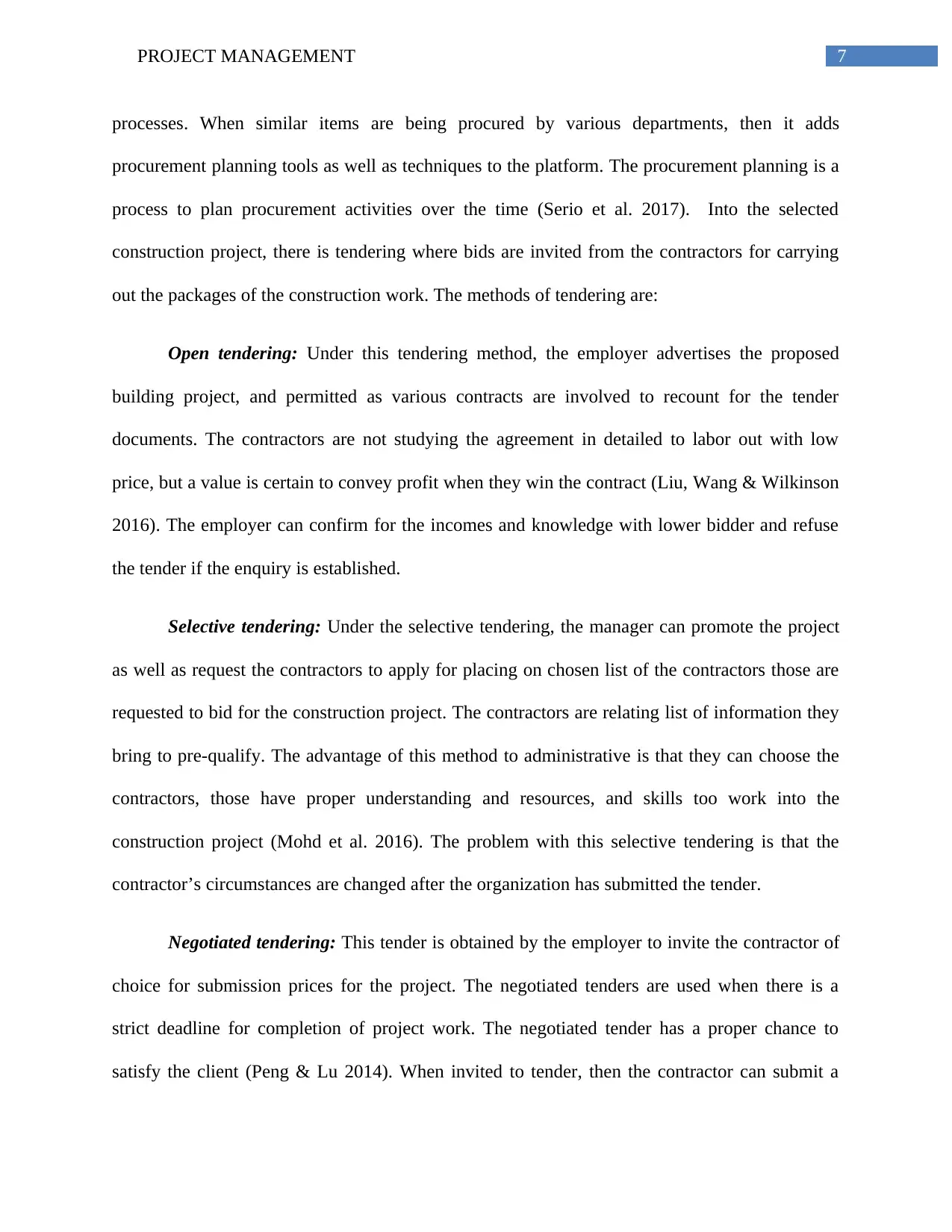
7PROJECT MANAGEMENT
processes. When similar items are being procured by various departments, then it adds
procurement planning tools as well as techniques to the platform. The procurement planning is a
process to plan procurement activities over the time (Serio et al. 2017). Into the selected
construction project, there is tendering where bids are invited from the contractors for carrying
out the packages of the construction work. The methods of tendering are:
Open tendering: Under this tendering method, the employer advertises the proposed
building project, and permitted as various contracts are involved to recount for the tender
documents. The contractors are not studying the agreement in detailed to labor out with low
price, but a value is certain to convey profit when they win the contract (Liu, Wang & Wilkinson
2016). The employer can confirm for the incomes and knowledge with lower bidder and refuse
the tender if the enquiry is established.
Selective tendering: Under the selective tendering, the manager can promote the project
as well as request the contractors to apply for placing on chosen list of the contractors those are
requested to bid for the construction project. The contractors are relating list of information they
bring to pre-qualify. The advantage of this method to administrative is that they can choose the
contractors, those have proper understanding and resources, and skills too work into the
construction project (Mohd et al. 2016). The problem with this selective tendering is that the
contractor’s circumstances are changed after the organization has submitted the tender.
Negotiated tendering: This tender is obtained by the employer to invite the contractor of
choice for submission prices for the project. The negotiated tenders are used when there is a
strict deadline for completion of project work. The negotiated tender has a proper chance to
satisfy the client (Peng & Lu 2014). When invited to tender, then the contractor can submit a
processes. When similar items are being procured by various departments, then it adds
procurement planning tools as well as techniques to the platform. The procurement planning is a
process to plan procurement activities over the time (Serio et al. 2017). Into the selected
construction project, there is tendering where bids are invited from the contractors for carrying
out the packages of the construction work. The methods of tendering are:
Open tendering: Under this tendering method, the employer advertises the proposed
building project, and permitted as various contracts are involved to recount for the tender
documents. The contractors are not studying the agreement in detailed to labor out with low
price, but a value is certain to convey profit when they win the contract (Liu, Wang & Wilkinson
2016). The employer can confirm for the incomes and knowledge with lower bidder and refuse
the tender if the enquiry is established.
Selective tendering: Under the selective tendering, the manager can promote the project
as well as request the contractors to apply for placing on chosen list of the contractors those are
requested to bid for the construction project. The contractors are relating list of information they
bring to pre-qualify. The advantage of this method to administrative is that they can choose the
contractors, those have proper understanding and resources, and skills too work into the
construction project (Mohd et al. 2016). The problem with this selective tendering is that the
contractor’s circumstances are changed after the organization has submitted the tender.
Negotiated tendering: This tender is obtained by the employer to invite the contractor of
choice for submission prices for the project. The negotiated tenders are used when there is a
strict deadline for completion of project work. The negotiated tender has a proper chance to
satisfy the client (Peng & Lu 2014). When invited to tender, then the contractor can submit a
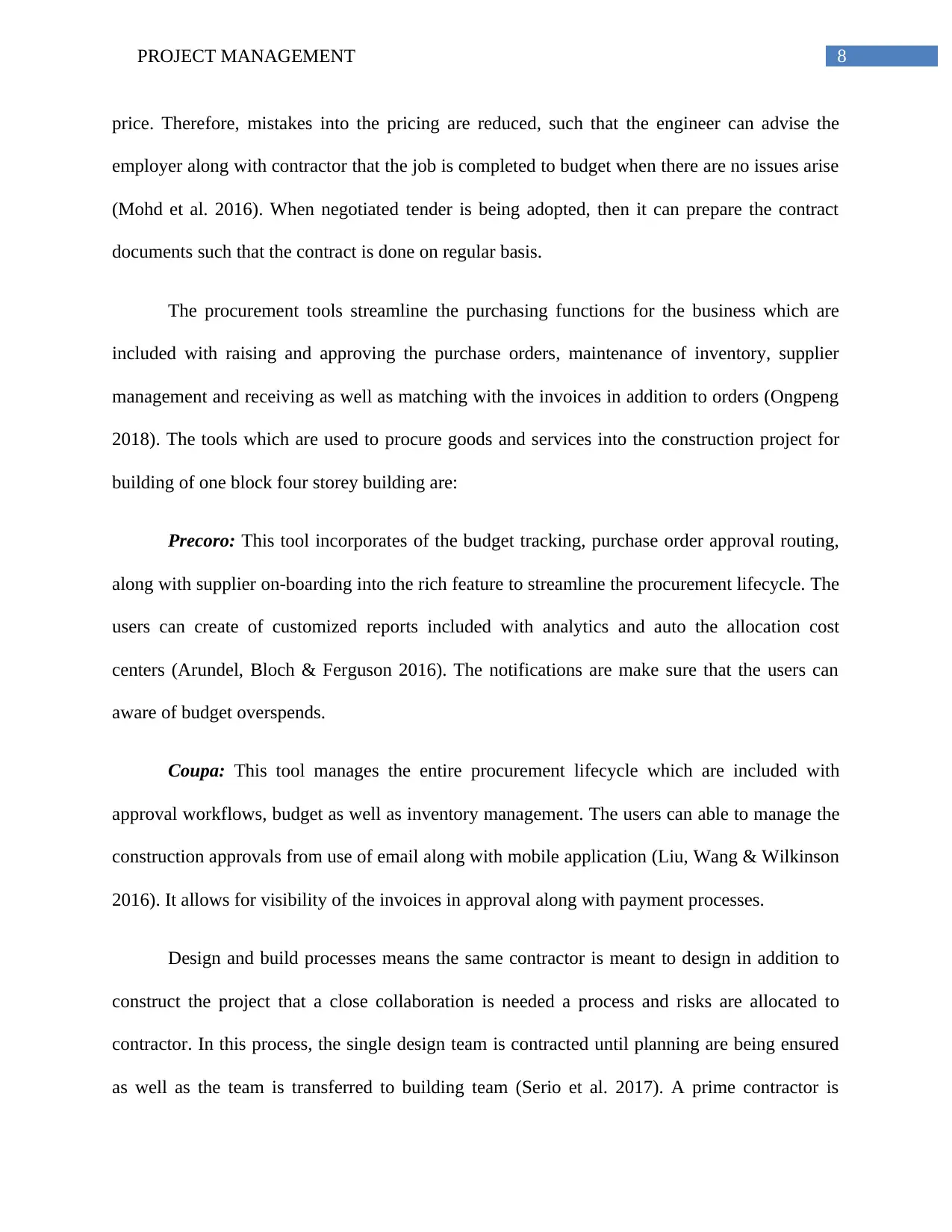
8PROJECT MANAGEMENT
price. Therefore, mistakes into the pricing are reduced, such that the engineer can advise the
employer along with contractor that the job is completed to budget when there are no issues arise
(Mohd et al. 2016). When negotiated tender is being adopted, then it can prepare the contract
documents such that the contract is done on regular basis.
The procurement tools streamline the purchasing functions for the business which are
included with raising and approving the purchase orders, maintenance of inventory, supplier
management and receiving as well as matching with the invoices in addition to orders (Ongpeng
2018). The tools which are used to procure goods and services into the construction project for
building of one block four storey building are:
Precoro: This tool incorporates of the budget tracking, purchase order approval routing,
along with supplier on-boarding into the rich feature to streamline the procurement lifecycle. The
users can create of customized reports included with analytics and auto the allocation cost
centers (Arundel, Bloch & Ferguson 2016). The notifications are make sure that the users can
aware of budget overspends.
Coupa: This tool manages the entire procurement lifecycle which are included with
approval workflows, budget as well as inventory management. The users can able to manage the
construction approvals from use of email along with mobile application (Liu, Wang & Wilkinson
2016). It allows for visibility of the invoices in approval along with payment processes.
Design and build processes means the same contractor is meant to design in addition to
construct the project that a close collaboration is needed a process and risks are allocated to
contractor. In this process, the single design team is contracted until planning are being ensured
as well as the team is transferred to building team (Serio et al. 2017). A prime contractor is
price. Therefore, mistakes into the pricing are reduced, such that the engineer can advise the
employer along with contractor that the job is completed to budget when there are no issues arise
(Mohd et al. 2016). When negotiated tender is being adopted, then it can prepare the contract
documents such that the contract is done on regular basis.
The procurement tools streamline the purchasing functions for the business which are
included with raising and approving the purchase orders, maintenance of inventory, supplier
management and receiving as well as matching with the invoices in addition to orders (Ongpeng
2018). The tools which are used to procure goods and services into the construction project for
building of one block four storey building are:
Precoro: This tool incorporates of the budget tracking, purchase order approval routing,
along with supplier on-boarding into the rich feature to streamline the procurement lifecycle. The
users can create of customized reports included with analytics and auto the allocation cost
centers (Arundel, Bloch & Ferguson 2016). The notifications are make sure that the users can
aware of budget overspends.
Coupa: This tool manages the entire procurement lifecycle which are included with
approval workflows, budget as well as inventory management. The users can able to manage the
construction approvals from use of email along with mobile application (Liu, Wang & Wilkinson
2016). It allows for visibility of the invoices in approval along with payment processes.
Design and build processes means the same contractor is meant to design in addition to
construct the project that a close collaboration is needed a process and risks are allocated to
contractor. In this process, the single design team is contracted until planning are being ensured
as well as the team is transferred to building team (Serio et al. 2017). A prime contractor is
⊘ This is a preview!⊘
Do you want full access?
Subscribe today to unlock all pages.

Trusted by 1+ million students worldwide
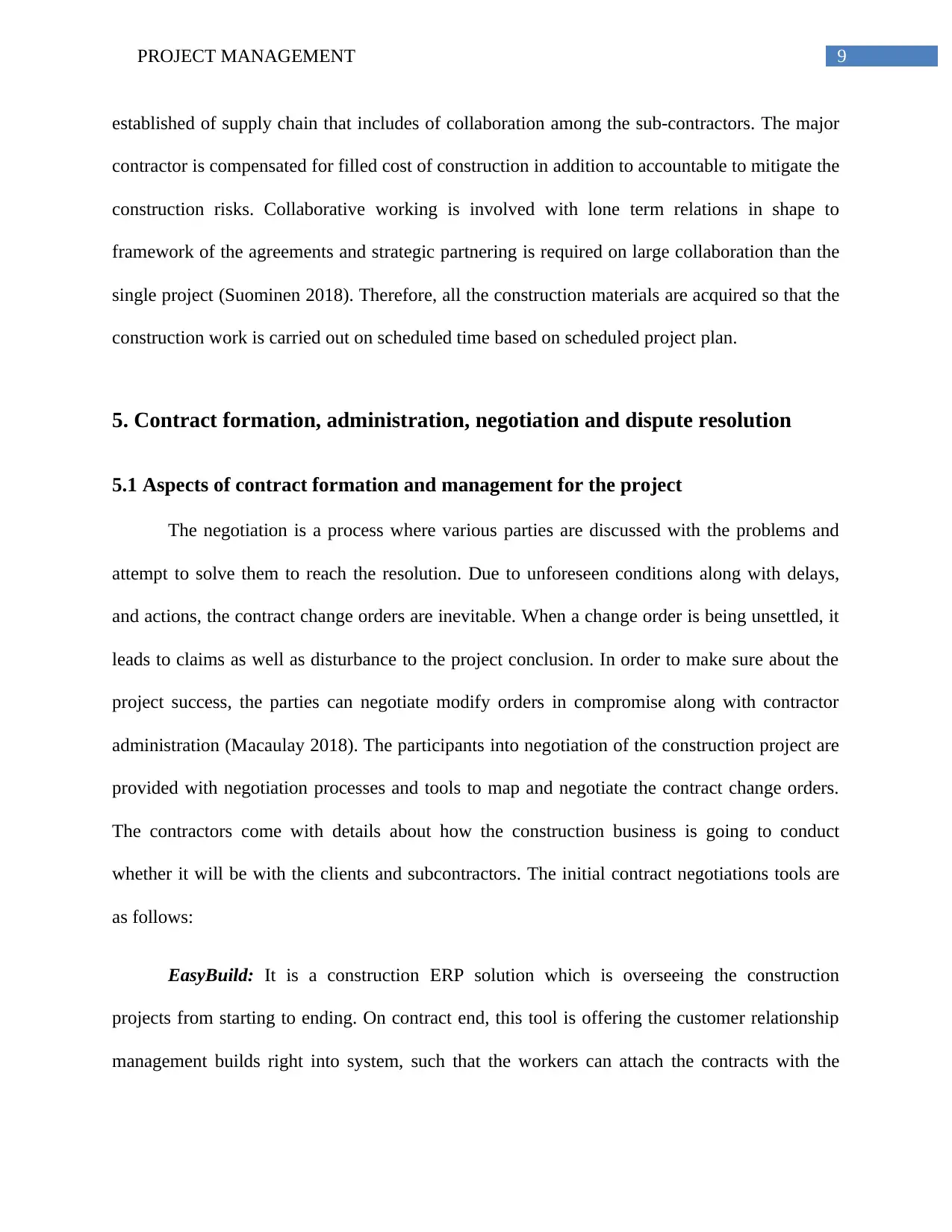
9PROJECT MANAGEMENT
established of supply chain that includes of collaboration among the sub-contractors. The major
contractor is compensated for filled cost of construction in addition to accountable to mitigate the
construction risks. Collaborative working is involved with lone term relations in shape to
framework of the agreements and strategic partnering is required on large collaboration than the
single project (Suominen 2018). Therefore, all the construction materials are acquired so that the
construction work is carried out on scheduled time based on scheduled project plan.
5. Contract formation, administration, negotiation and dispute resolution
5.1 Aspects of contract formation and management for the project
The negotiation is a process where various parties are discussed with the problems and
attempt to solve them to reach the resolution. Due to unforeseen conditions along with delays,
and actions, the contract change orders are inevitable. When a change order is being unsettled, it
leads to claims as well as disturbance to the project conclusion. In order to make sure about the
project success, the parties can negotiate modify orders in compromise along with contractor
administration (Macaulay 2018). The participants into negotiation of the construction project are
provided with negotiation processes and tools to map and negotiate the contract change orders.
The contractors come with details about how the construction business is going to conduct
whether it will be with the clients and subcontractors. The initial contract negotiations tools are
as follows:
EasyBuild: It is a construction ERP solution which is overseeing the construction
projects from starting to ending. On contract end, this tool is offering the customer relationship
management builds right into system, such that the workers can attach the contracts with the
established of supply chain that includes of collaboration among the sub-contractors. The major
contractor is compensated for filled cost of construction in addition to accountable to mitigate the
construction risks. Collaborative working is involved with lone term relations in shape to
framework of the agreements and strategic partnering is required on large collaboration than the
single project (Suominen 2018). Therefore, all the construction materials are acquired so that the
construction work is carried out on scheduled time based on scheduled project plan.
5. Contract formation, administration, negotiation and dispute resolution
5.1 Aspects of contract formation and management for the project
The negotiation is a process where various parties are discussed with the problems and
attempt to solve them to reach the resolution. Due to unforeseen conditions along with delays,
and actions, the contract change orders are inevitable. When a change order is being unsettled, it
leads to claims as well as disturbance to the project conclusion. In order to make sure about the
project success, the parties can negotiate modify orders in compromise along with contractor
administration (Macaulay 2018). The participants into negotiation of the construction project are
provided with negotiation processes and tools to map and negotiate the contract change orders.
The contractors come with details about how the construction business is going to conduct
whether it will be with the clients and subcontractors. The initial contract negotiations tools are
as follows:
EasyBuild: It is a construction ERP solution which is overseeing the construction
projects from starting to ending. On contract end, this tool is offering the customer relationship
management builds right into system, such that the workers can attach the contracts with the
Paraphrase This Document
Need a fresh take? Get an instant paraphrase of this document with our AI Paraphraser
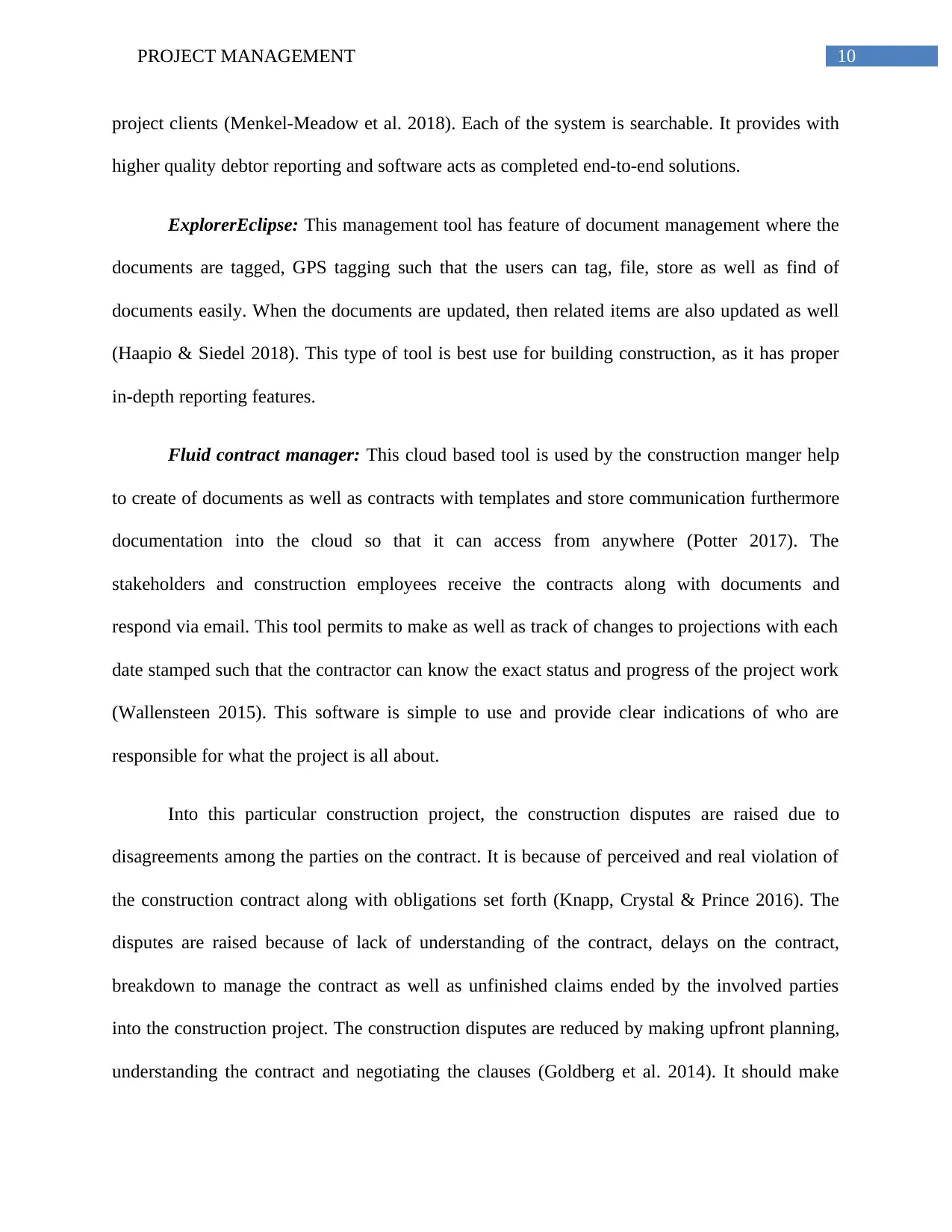
10PROJECT MANAGEMENT
project clients (Menkel-Meadow et al. 2018). Each of the system is searchable. It provides with
higher quality debtor reporting and software acts as completed end-to-end solutions.
ExplorerEclipse: This management tool has feature of document management where the
documents are tagged, GPS tagging such that the users can tag, file, store as well as find of
documents easily. When the documents are updated, then related items are also updated as well
(Haapio & Siedel 2018). This type of tool is best use for building construction, as it has proper
in-depth reporting features.
Fluid contract manager: This cloud based tool is used by the construction manger help
to create of documents as well as contracts with templates and store communication furthermore
documentation into the cloud so that it can access from anywhere (Potter 2017). The
stakeholders and construction employees receive the contracts along with documents and
respond via email. This tool permits to make as well as track of changes to projections with each
date stamped such that the contractor can know the exact status and progress of the project work
(Wallensteen 2015). This software is simple to use and provide clear indications of who are
responsible for what the project is all about.
Into this particular construction project, the construction disputes are raised due to
disagreements among the parties on the contract. It is because of perceived and real violation of
the construction contract along with obligations set forth (Knapp, Crystal & Prince 2016). The
disputes are raised because of lack of understanding of the contract, delays on the contract,
breakdown to manage the contract as well as unfinished claims ended by the involved parties
into the construction project. The construction disputes are reduced by making upfront planning,
understanding the contract and negotiating the clauses (Goldberg et al. 2014). It should make
project clients (Menkel-Meadow et al. 2018). Each of the system is searchable. It provides with
higher quality debtor reporting and software acts as completed end-to-end solutions.
ExplorerEclipse: This management tool has feature of document management where the
documents are tagged, GPS tagging such that the users can tag, file, store as well as find of
documents easily. When the documents are updated, then related items are also updated as well
(Haapio & Siedel 2018). This type of tool is best use for building construction, as it has proper
in-depth reporting features.
Fluid contract manager: This cloud based tool is used by the construction manger help
to create of documents as well as contracts with templates and store communication furthermore
documentation into the cloud so that it can access from anywhere (Potter 2017). The
stakeholders and construction employees receive the contracts along with documents and
respond via email. This tool permits to make as well as track of changes to projections with each
date stamped such that the contractor can know the exact status and progress of the project work
(Wallensteen 2015). This software is simple to use and provide clear indications of who are
responsible for what the project is all about.
Into this particular construction project, the construction disputes are raised due to
disagreements among the parties on the contract. It is because of perceived and real violation of
the construction contract along with obligations set forth (Knapp, Crystal & Prince 2016). The
disputes are raised because of lack of understanding of the contract, delays on the contract,
breakdown to manage the contract as well as unfinished claims ended by the involved parties
into the construction project. The construction disputes are reduced by making upfront planning,
understanding the contract and negotiating the clauses (Goldberg et al. 2014). It should make
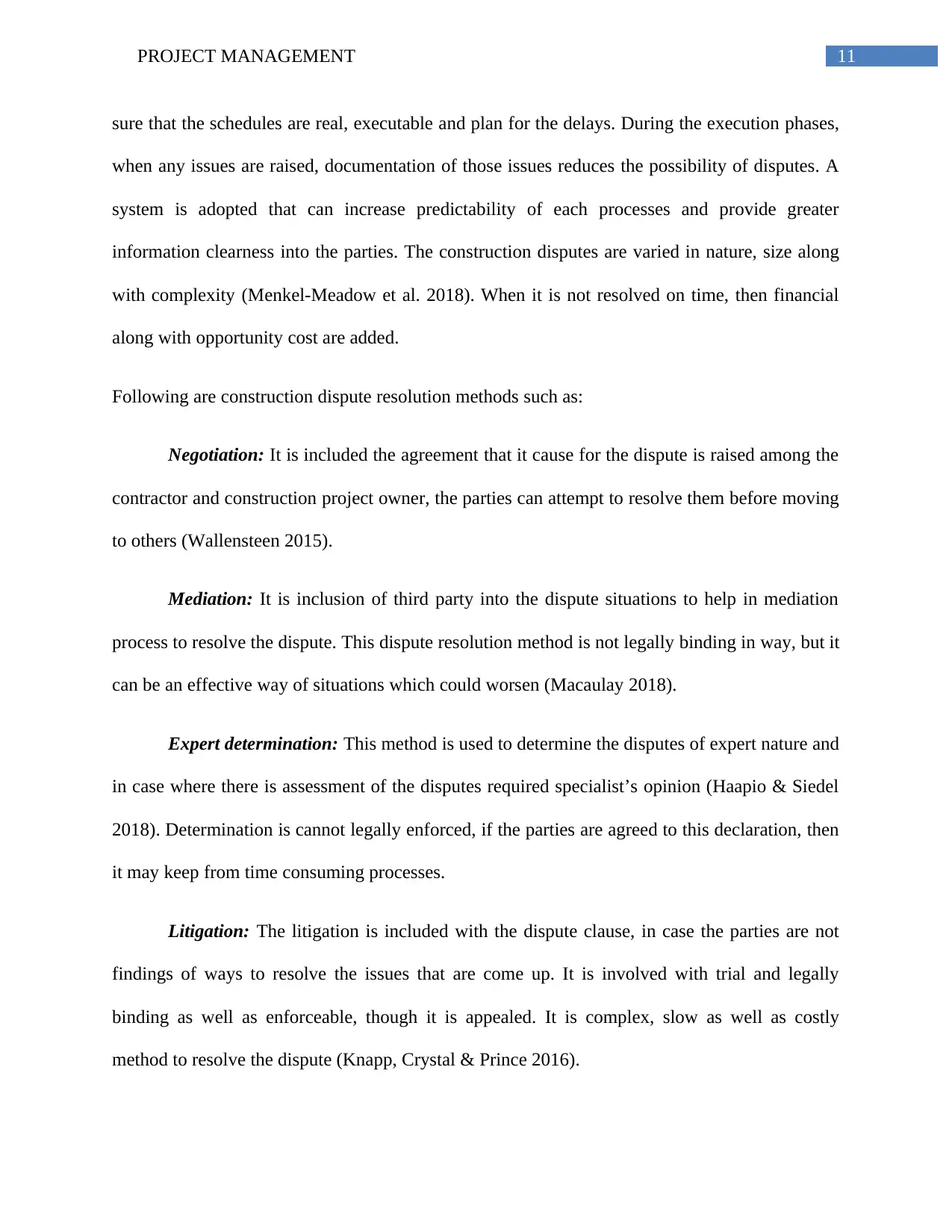
11PROJECT MANAGEMENT
sure that the schedules are real, executable and plan for the delays. During the execution phases,
when any issues are raised, documentation of those issues reduces the possibility of disputes. A
system is adopted that can increase predictability of each processes and provide greater
information clearness into the parties. The construction disputes are varied in nature, size along
with complexity (Menkel-Meadow et al. 2018). When it is not resolved on time, then financial
along with opportunity cost are added.
Following are construction dispute resolution methods such as:
Negotiation: It is included the agreement that it cause for the dispute is raised among the
contractor and construction project owner, the parties can attempt to resolve them before moving
to others (Wallensteen 2015).
Mediation: It is inclusion of third party into the dispute situations to help in mediation
process to resolve the dispute. This dispute resolution method is not legally binding in way, but it
can be an effective way of situations which could worsen (Macaulay 2018).
Expert determination: This method is used to determine the disputes of expert nature and
in case where there is assessment of the disputes required specialist’s opinion (Haapio & Siedel
2018). Determination is cannot legally enforced, if the parties are agreed to this declaration, then
it may keep from time consuming processes.
Litigation: The litigation is included with the dispute clause, in case the parties are not
findings of ways to resolve the issues that are come up. It is involved with trial and legally
binding as well as enforceable, though it is appealed. It is complex, slow as well as costly
method to resolve the dispute (Knapp, Crystal & Prince 2016).
sure that the schedules are real, executable and plan for the delays. During the execution phases,
when any issues are raised, documentation of those issues reduces the possibility of disputes. A
system is adopted that can increase predictability of each processes and provide greater
information clearness into the parties. The construction disputes are varied in nature, size along
with complexity (Menkel-Meadow et al. 2018). When it is not resolved on time, then financial
along with opportunity cost are added.
Following are construction dispute resolution methods such as:
Negotiation: It is included the agreement that it cause for the dispute is raised among the
contractor and construction project owner, the parties can attempt to resolve them before moving
to others (Wallensteen 2015).
Mediation: It is inclusion of third party into the dispute situations to help in mediation
process to resolve the dispute. This dispute resolution method is not legally binding in way, but it
can be an effective way of situations which could worsen (Macaulay 2018).
Expert determination: This method is used to determine the disputes of expert nature and
in case where there is assessment of the disputes required specialist’s opinion (Haapio & Siedel
2018). Determination is cannot legally enforced, if the parties are agreed to this declaration, then
it may keep from time consuming processes.
Litigation: The litigation is included with the dispute clause, in case the parties are not
findings of ways to resolve the issues that are come up. It is involved with trial and legally
binding as well as enforceable, though it is appealed. It is complex, slow as well as costly
method to resolve the dispute (Knapp, Crystal & Prince 2016).
⊘ This is a preview!⊘
Do you want full access?
Subscribe today to unlock all pages.

Trusted by 1+ million students worldwide
1 out of 20
Your All-in-One AI-Powered Toolkit for Academic Success.
+13062052269
info@desklib.com
Available 24*7 on WhatsApp / Email
![[object Object]](/_next/static/media/star-bottom.7253800d.svg)
Unlock your academic potential
Copyright © 2020–2025 A2Z Services. All Rights Reserved. Developed and managed by ZUCOL.

